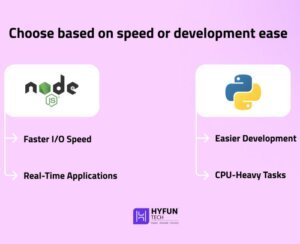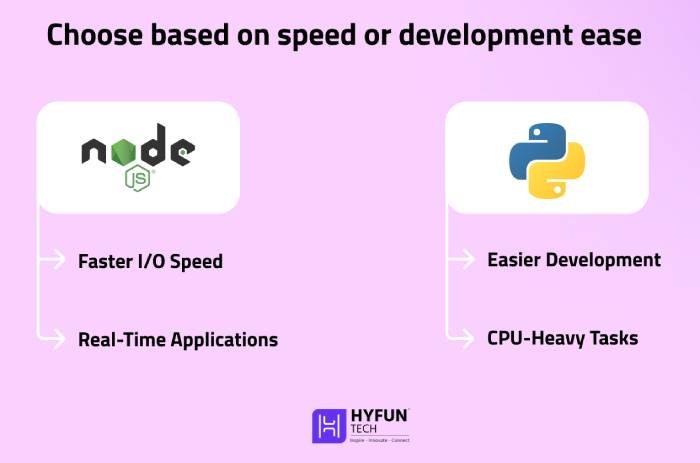In modern web development, the choice between Node.js vs Python as a backend technology is a common question. Both power high-profile sites and have strong developer communities. A survey of over 58,000 developers highlights how critical backend frameworks are, and both Node.js and Python rank near the top. Backend languages power the core logic of web apps – from database queries to business workflows.
Choosing the right one can affect performance, developer productivity, and long-term maintenance. Node.js and Python are both general-purpose, but have different design philosophies. Node.js brings JavaScript’s event-driven model to servers, while Python emphasizes readability and a rich standard library. Knowing their differences will help you ( like it did for us at Hyfuntech) make an informed decision, rather than choosing based on trends alone. As developers at Hyfuntech, we’ve built projects in both languages.
This guide will explain their differences in easy words. We will cover performance, scalability, ecosystems, and use cases too. Node.js brings JavaScript which is the web’s most popular language. Also for the backend, opening backend development to front-end developers. Python’s clear syntax has made it a common teaching language for beginners.
What is Node.js?
Node.js uses Google’s V8 JavaScript engine. JavaScript runs on servers, not only browsers. Node.js can manage multiple connections without stalling due to its asynchronous, event-driven nature. Ryan Dahl’s 2009 release revolutionized web app development. The npm registry has over 1.3 million packages for Node.js. Express.js and NestJS are used to structure Node.js projects. This helps front-end developers to reuse backend code like form validation logic. It opened up backend development to front-end developers, letting web teams use one language for everything.
What is Python?
Python is a multifunctional, high-level programming language with simple syntax. Python powers small programs, huge web services, and scientific instruments. Guido van Rossum created it in 1991. Developers can create logic in fewer lines because its code is generally simple English. Python has a large data science, machine learning, and Django, Flask, and FastAPI library ecosystem. The package manager Pip simplifies library installation and management. It supports procedural, object-oriented, and functional paradigms, giving developers flexibility. Its readability made it a popular teaching language – many beginners learn programming with Python.
Let’s Rate Them Both in Various Criterias
1. Performance and Speed
One big difference is raw speed. Node.js often runs faster for web tasks. Its V8 engine compiles JavaScript into optimized machine code, and its non-blocking I/O model lets the server handle a new request while waiting on previous ones. V8 even uses Just-In-Time compilation to speed execution, whereas standard Python (CPython) is an interpreted language (PyPy is a JIT alternative). In benchmarks, Node.js frameworks typically show higher throughput than Python frameworks. This matches the idea that Node.js “wins the race” on performance. In practice, Node.js can handle thousands of requests per second for I/O-bound tasks like database queries or API calls. It excels at real-time applications (chats, live dashboards, streaming apps) and high-traffic sites. In fact, in benchmarks a Node.js API can serve roughly 2–3× more requests per second than a similar Python/Flask service on the same hardware. In real apps, however, much of the time is spent on databases or networks, so the gap is often smaller.

Python, by contrast, is traditionally slower for serving web requests. Python code is usually interpreted and executes one statement at a time. Its Global Interpreter Lock (GIL) means only one thread of Python bytecode runs at a time, which can limit concurrency. In a typical web server, Python (e.g. a Flask app) often handles fewer requests per second than Node.js. However, Python can use asynchronous libraries (asyncio) or multi-process servers (Gunicorn) to improve throughput. For CPU-heavy tasks (like image processing or data crunching), Python can leverage optimized C libraries (NumPy, Cython) or use multiple processes, whereas Node.js would need external workers. For example, Node.js comes with worker threads (in recent versions) and cluster support, but many teams still offload CPU work to separate services. In short, Node.js usually leads in raw I/O speed and concurrency, while Python trades some speed for ease of development and its powerful libraries.
2. Scalability and Concurrency
Scalability is about handling more users or data as an app grows. Node.js is designed to scale easily. Its non-blocking, event-driven model works well with horizontal scaling (adding more servers). You can run multiple Node.js instances (for example, one per CPU core) without major changes. Prismetric notes that Node.js applications can be scaled with new nodes and resources with minimal changes. Teams often break Node apps into microservices – small independent services – which can be deployed and scaled separately. In cloud environments, Node.js functions and containers are well-supported (AWS Lambda, Azure Functions, etc.). For example, large systems often use message queues (RabbitMQ, Kafka) to distribute work between services, whether they are written in Node.js or Python. Caching layers (Redis) and CDNs are commonly used with either stack. In other words, both ecosystems have robust support for modern infrastructure. Ultimately, both languages can power systems that serve millions of users if designed properly. For example, Node.js comes with a built-in cluster module to spawn worker processes, and Python deployments often use Gunicorn or uWSGI for multiple workers.
Python can also scale, but its GIL means it handles concurrency differently. A common approach is to run several Python worker processes behind a load balancer, or use async frameworks (aiohttp, FastAPI) that use event loops. Prismetric highlights that Python’s GIL “prevents numerous threads from operating simultaneously,” so true multi-threading is limited. In practice, Python apps often scale by running multiple processes or containers. Both Node.js and Python benefit from containerization (Docker) and modern cloud setups, so you can achieve large scale with good architecture. Both can also scale vertically (using bigger servers), but web backends usually scale by adding more instances horizontally.
3. Ecosystem and Libraries
Both Node.js and Python have very mature ecosystems, but with different focuses:
- Node.js ecosystem: centered around npm (Node Package Manager), which hosts over 1.3 million packages. This has web frameworks (Express, Koa), real-time libraries (Socket.IO), and many utility modules. Developers working in nodejs development benefit from using the same language (JavaScript/TypeScript) across frontend and backend. For example, teams often use a MERN stack (MongoDB, Express, React, Node.js) for their web apps. Popular databases like PostgreSQL, MySQL, and MongoDB have excellent support for Node.js. For example, other Node.js frameworks come with Hapi, Koa, and Fastify.
- Python ecosystem: centered around PyPI (Python Package Index) with hundreds of thousands of packages (PyPI hosts over 300,000). Python shines in data and scientific libraries (NumPy, Pandas, TensorFlow, PyTorch). It also has mature web frameworks: Django provides a ‘batteries-included’ way (ORM, auth, admin panel), while Flask and FastAPI offer lightweight alternatives. For example, Python projects often use Django with a React or Vue front-end. Major databases are also well-supported (Django ORM, SQLAlchemy, etc.). Python’s standard library is also very rich, covering many common tasks (file I/O, HTTP, data formats, etc.) out of the box.
In practice, many web projects use a JS-based stack (like MERN) or a Python stack (like Django + React). Both communities continually add new libraries and tools, so you can usually find a package for your needs. As Prismetric notes, both technologies offer a range of libraries and tools to streamline development.
4. Community and Support
Community size and activity are strong for both languages. Node.js is younger (since 2009) but very popular. JavaScript consistently tops developer surveys, and Node.js in particular is widely used for web backends. For example, StackOverflow’s 2022 survey reported Node.js as the most popular framework for web development, and Node.js is one of GitHub’s most-starred projects. Companies like Netflix, LinkedIn, and PayPal use Node.js in production and have reported large performance gains. The Node.js community constantly releases new modules and tools. This keeps the ecosystem fresh, but also means you should manage dependencies carefully.
Python has one of the largest developer communities. It’s often ranked near the top in popularity indexes. Python is heavily used in academia and industry for tasks from web to data science, so expertise is abundant. There are huge online resources, tutorials, and Q&A for both Node.js and Python, making it easy to find help. Many surveys list Python in the top 5 languages and Node.js in the top 10. For example, GitHub’s 2022 survey placed Python as the third most popular language globally, with JavaScript (Node.js) also ranking highly. Glassdoor reports average salaries in the US around $98K for Node.js developers and $117K for Python developers, reflecting high demand. Both communities hold conferences and meetups (e.g., PyCon, Node Interactive) and contribute to open-source. Both Node.js and Python are open-source under permissive licenses (Node under MIT, Python under PSF license). According to popularity rankings (e.g. TIOBE), Python and JavaScript are consistently among the top 3 languages. Both ecosystems are well-supported and constantly evolving.
5. Development Ease and Learning Curve
- Python: Often praised for easy syntax and readability. Python code tends to be concise and consistent (using indentation). This makes it quick to prototype and maintain. A beginner can often start producing useful Python code with minimal setup.
- Node.js (JavaScript): Easy for developers already familiar with JavaScript. Using the same language across frontend and backend (often with TypeScript) can speed up full-stack development. However, Node.js’s asynchronous style (callbacks, Promises, async/await) requires care. Beginners may find async patterns challenging at first.
- Debugging: Python’s straightforward execution model often makes errors easier to trace. Node.js’s event loop and async callbacks mean you have to manage errors carefully. Prismetric notes that Node.js’s concurrency can make it harder to spot bugs, whereas Python’s sequential flow is easier to scan for errors.
- Typing: Node.js often uses TypeScript to add static typing and catch errors early. Python is dynamically typed by default, though it now supports optional type hints (PEP 484) that can be checked with tools (like mypy).
- Tooling: Both languages enjoy excellent tooling support. Node.js developers commonly use IDEs like Visual Studio Code or WebStorm. Python developers often use PyCharm or VS Code, and data scientists frequently use Jupyter notebooks for interactive development. Python developers often isolate projects with virtual environments (venv, conda) to manage dependencies, whereas Node.js uses npm (or yarn) per project to avoid global conflicts.
6. Use Cases and Real-World Examples
- Real-time Apps: Node.js shines for chat apps, live games, collaboration tools, and streaming. Its non-blocking I/O and built-in WebSocket support make broadcasting to many clients easy. For example, LinkedIn’s mobile server and parts of Netflix use Node.js to improve response times.
- Microservices/APIs: Both can build web APIs. Node.js is JSON-native (JavaScript↔JSON) and is often used for lightweight REST or GraphQL services. Python (with Flask/FastAPI) is equally capable. Teams sometimes mix them: for example, one service might be in Node.js while another is in Python.
- CPU-intensive Tasks: When the server does heavy computation (image processing, complex algorithms), Python often has the edge via optimized libraries (written in C) or parallelism. For instance, Dropbox and Instagram rely on Python for backend processing. Node.js can handle CPU work too (using worker threads or external services), but this is less common.
- Data Science and ML: Python is dominant in data science. Libraries like TensorFlow, PyTorch, and Pandas make analytics and machine learning straightforward. Backend services serving ML models are usually in Python (Flask, Django). Node.js can serve models via REST APIs, but heavy lifting is often done in Python.
- Automation and Scripting: Python excels at general-purpose scripting, automation, and DevOps tasks (e.g., Ansible is Python-based). Node.js can also script development tasks (npm scripts, Gulp), but Python’s simplicity often makes it the choice for complex automation or command-line tools.
- E-commerce & CMS: Both languages power content sites and online stores. Python’s Django comes with built-in admin and authentication, speeding up e-commerce development. Node.js often pairs with modern frontend frameworks (React, Vue) to create dynamic shopping experiences.
- Serverless: Both Node.js and Python run on AWS Lambda, Azure Functions, and other serverless platforms. Node.js often has faster cold-start times, while Python is widely used in serverless data-processing tasks.
- Getting Talent: Consider your team. There are many JavaScript developers (especially front-end) who can pick up Node.js. Python developers are also abundant, particularly in the scientific community. If your team has stronger skills in one language, that might guide your choice.
Each technology has success stories. For example, Instagram’s backend is built in Python (Django), and many startups use Python for quick MVPs. On the Node side, companies like Netflix, PayPal, and LinkedIn use Node.js for key services. Many large projects use both. The key is matching each language’s strengths to your project’s requirements. Often, teams use both: for example, one service might be in Node.js while another is in Python. If in doubt, try quick prototypes in each – it often becomes clear which language fits your problem and team best.
Compiling All the Pros and Cons of Python & Node.js
Node.js Pros:
- Extremely fast for I/O-bound and real-time tasks (V8 engine, event loop).
- Huge ecosystem with npm and millions of packages.
- Same language (JS/TypeScript) across client and server.
- Handles many concurrent connections easily (great for chat, games).
- Fast startup time for small scripts or microservices.
- Scales out with microservices and clustering.
Node.js Cons:
- Single-threaded nature can struggle with heavy CPU tasks.
- Asynchronous programming can be complex (callbacks, Promises) (sometimes called “callback hell”).
- Debugging async code can be harder.
- Relies heavily on third-party npm modules (monitor security).
Python Pros:
- Clean, concise syntax – easier for beginners.
- Vast libraries for everything (especially data and AI).
- Mature frameworks (Django, Flask) with built-in tools.
- Great for CPU-bound workloads using optimized libraries.
- Large, supportive community and many learning resources.
Python Cons:
- Generally slower for high-concurrency web workloads (GIL, no true threads).
- Scaling requires multi-process setups or async code.
- Not originally designed for real-time I/O (though asyncio helps).
- Historically fewer libraries for real-time apps (though this is changing).
- Strict indentation can confuse newcomers.
When to Choose Python and Node.js?
There is no one-size-fits-all answer. At Hyfuntech, we advise: pick the tool that fits your project.
Choose Node.js if: you need a high-performance backend with real-time capabilities, your team is strong in JavaScript, or you want a unified JS stack across client and server. Node.js is great for lightweight APIs, microservices, and apps where speed is crucial.
Choose Python if: your project involves heavy data processing, machine learning, or scientific computing, or if you value rapid development with clear syntax. Python is ideal when working with complex algorithms or data analysis. Often, teams use both; for example, one service might be in Node.js while another is in Python.
The key is to align each language’s strengths to your needs. Our experience shows that even within one project, Node.js and Python can complement each other. If in doubt, try quick prototypes in each – it often becomes clear which language fits your problem and team best.
Final Verdict
Node.js and Python are both excellent choices for backend web development. Node.js offers very high concurrency and fast I/O performance, making it ideal for real-time, high-throughput applications. Python provides clean, concise syntax and unbeatable libraries for data and AI. In practice, we at Hyfuntech choose based on project needs – there’s no absolute “winner,” only trade-offs. For each project, consider factors like expected load, development speed, and your team’s expertise.
Both Node.js and Python have scheduled releases and long-term support. For example, Node.js offers about 30 months of support for each LTS release, while Python typically provides security updates for about 5 years for each version. Both ecosystems keep evolving, and with either platform you get strong community support and robust tools. Whichever you pick, both ecosystems will continue to improve.
Stay aware of new releases and best practices to keep your project current. By understanding their differences, you can resolve the “great backend dilemma” and pick the language that best suits your goals. At Hyfuntech, we stay on top of both Node.js and Python trends to advise clients properly.
Choosing one or the other should be driven by your use case, not buzz. Both have large communities and plenty of experts. Either way, a large community supports you both. Building a robust backend also depends on good practices (testing, monitoring, optimization) more than the language itself. Our team at Hyfuntech is here to help guide that decision.



